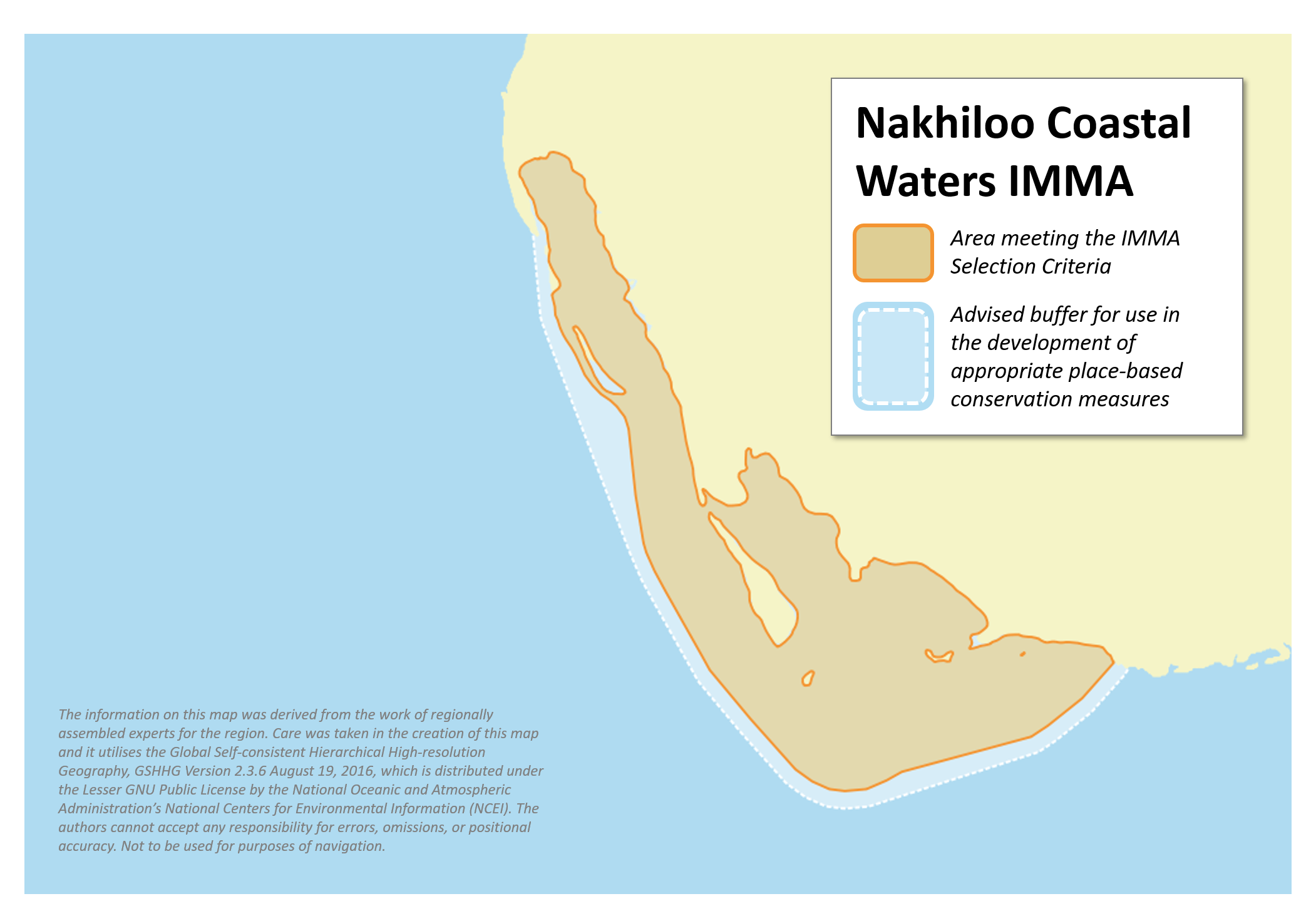Nakhiloo Coastal Waters IMMA
Size in Square Kilometres
401 km2
Qualifying Species and Criteria
Indian Ocean humpback dolphin – Sousa plumbea
Criterion A; B (1)
Finless porpoise – Neophocaena phocaenoides
Criterion A; C (1)
Marine Mammal Diversity
Neophocaena phocaenoides, Sousa plumbea, Balaenoptera edeni, Stenella longirostris, Delphinus delphis tropicalis
Download fact sheet
Summary
This IMMA, located at the mouth of the Mond River Delta in the Bushehr province in southern Iran, encompasses the Dayer-Nakhiloo National Marine Park. The park is 20,434 hectares in size and includes shallow coastal waters with mangrove forests. These waters support the a small, resident population of Endangered Indian Ocean humpback dolphins (Sousa plumbea). Surveys conducted year-round between 2014 and 2019 (a total of 42 months of research and 127 surveys) have yielded 97 sightings of Indian Ocean humpback dolphins and four sightings of finless porpoises (Neophocaena phocaenoides). These boat-based surveys also allowed the photo-identification of 39 individual Indian Ocean humpback dolphins resident in the area. Opportunistic sightings of both species further indicate their regular presence in the Nakhiloo National Marine Park. Both of these species are threatened by trawl fisheries, gillnet fisheries, and coastal development activities occurring in the IMMA.
Description of Qualifying Criteria
Criterion A – Species or Population Vulnerability
The IMMA supports the year-round presence of Indian Ocean humpback dolphins (Sousa plumbea), listed as EN on the IUCN red list of threatened species, which are present in a small resident population. Year-round monitoring of Indian Ocean humpback dolphins using boat-based surveys has allowed the photo-identification of 39 individuals resident in the area. Year-round surveys have been conducted between 2014 and 2019 (42 months of research). Their limited coastal range and near-shore distribution make this small community of humpback dolphins particularly vulnerable to mortality and traumatic injury in trawl nets and gillnets. One of the most famous shrimps (Penaeus semisulcatus) fishing grounds in the Persian Gulf is located around and inside the area with a considerable shrimp bottom trawling effort. Gillnet, fishing trap (local name Gargoor) and other traditional fisheries are also present.
Criterion B: Distribution and Abundance
Sub-criterion B1: Small and Resident Populations
Based on field surveys conducted Nakhiloo national park and Mond protected area from 2014-2019 abundance of Indian ocean humpback dolphins was estimated using photo-identification and closed population mark-recapture models. The discovery curve had plateaued suggesting that the majority of the population had been identified. A photo-identification catalogue of Indian Ocean humpback dolphins generated from the surveys identified 39 unique dorsal fins (Mohsenian, unpublished).
Criterion C: Key Life Cycle Activities
Sub-criterion C1: Reproductive Areas
The first observation of a humpback dolphin mother and new-born calf was made on 16 July 2017. Previously, only groups of juvenile humpback dolphins had been confirmed in this area. Mating behaviour was directly observed in groups of humpback dolphins every year. As the population is presumably resident within the Nakhiloo Marine Park and calves and reproductive behaviour are observed, we conclude that this is an important area for humpback dolphin reproduction. The presence of new-born finless porpoises was confirmed by the observation of a dead calf in close proximity an adult swimming around the carcass on 14 April 2017.
Supporting Information
Braulik, G.T., Findlay K., Cerchio, S. and Baldwin, R. 2015. ‘Assessment of the conservation status of the Indian Ocean humpback dolphin (Sousa plumbea) using the IUCN Red List Criteria’. Advance Marine Biology. 72:119-141. DOI: 10.1016/bs.amb.2015.08.004.
Braulik, G. T., Ranjbar, S., Owfi, F., Aminrad, T., Dakhteh, S. M. H., Kamrani, E. and Mohsenizadeh, F. (2010). ‘Marine mammal records from Iran’. Journal Cetacean Res. Manage, 11(1), 49–63
Jefferson, T. A., Webber, M. A., and Pitman, R. L. (2015). Marine Mammals of the world. A Comprehensive Guide to Their Identification. Second edition. Academic Press (USA).
Mohsenian, N., Moshiri, H. et al. Forthcoming. Conservation of Indian Ocean humpback dolphin, Sousa plumbea in dayyer nakhiloo marine national park and Mond protected area.
Preen, A. 2014. ‘Distribution, abundance and conservation status of dugongs and dolphins in the southern and western Arabian Gulf’. Biological Conservation, 118 (205-218).
Keijl, G., Van der Have, T. 2000. ‘Observations on marine mammals in southern Iran, January 2000’. Zoology in the Middle Ease 26(1):37-40, August 2002.
Sheppard, C.R., 1993. ‘Physical environment of the Gulf relevant to marine pollution: an overview’. Marine Pollution Bulletin, 27, pp.3-8.


